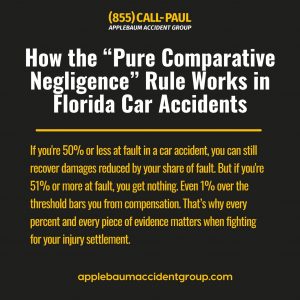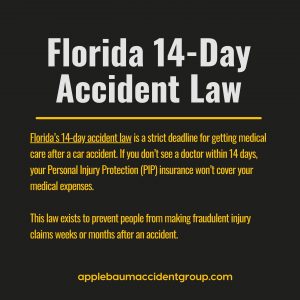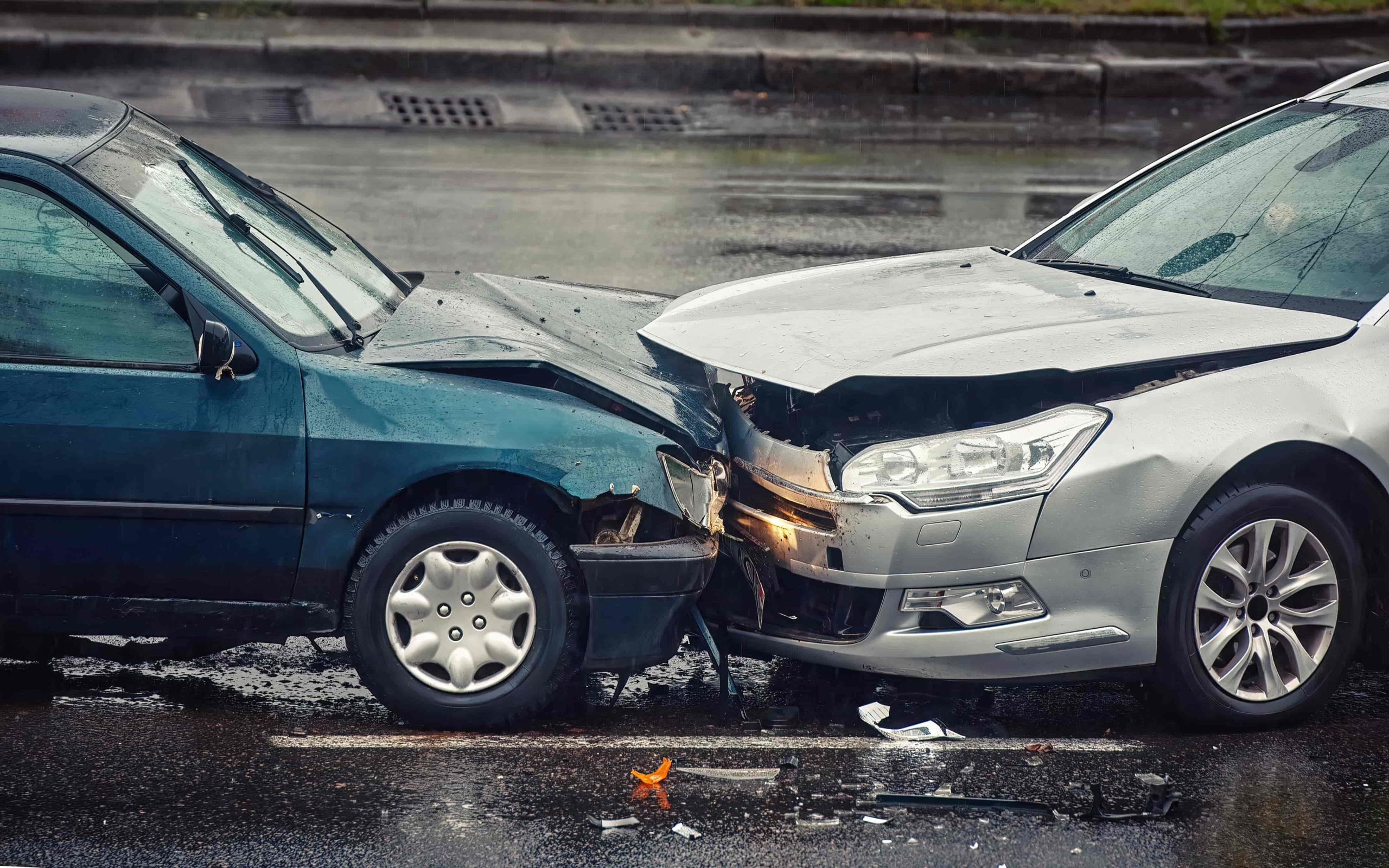Florida uses a modified comparative negligence rule: if you’re 50% or less at fault, you can recover damages, reduced by your share of fault. If you’re more than 50% at fault, you cannot recover compensation. This rule directly affects your payout after a crash.
If you’ve been in a Florida car accident and share some blame, you’re probably wondering: “Will I still get paid?”
Under Florida’s new 51% rule, you can recover damages only if you’re half or less at fault. If you’re 51% responsible, or more, you walk away with nothing.
This article breaks down how comparative negligence impacts your settlement, how insurance companies use it against you, and what you can do to fight back. You’ll also learn how it interacts with PIP, insurance limits, and legal strategy, and how to avoid costly mistakes, even if you admitted fault or missed seeing a doctor.
What Is Comparative Negligence

Florida’s car accident laws have long included a concept known as comparative negligence, a system that allows fault to be shared between multiple parties involved in an accident. For decades, Florida operated under the pure comparative negligence rule, which meant that even if you were 90% at fault, you could still recover 10% of your damages. That’s no longer the case.
As of March 24, 2023, Florida adopted a modified comparative negligence model under House Bill 837, also called the 51% rule. Under this framework, if you are found to be more than 50% responsible for your own injuries, you are completely barred from receiving any financial compensation.
Whether your claim involves vehicle damage, hospital bills, or pain and suffering, your percentage of fault is now the gatekeeper to recovery.
The rule doesn’t affect all personal injury cases equally. One significant exception remains: medical malpractice claims are still judged under the former, more forgiving pure comparative fault standard. In those cases, you can still receive compensation even if you’re mostly to blame, so long as you’re not 100% responsible.
What You Need to Know About HB 837
Florida lawmakers passed House Bill 837 to reform the state’s tort system. While much of the attention has gone to the fault threshold, this bill also cut the statute of limitations for personal injury lawsuits in half, from four years to two.
If you’re planning to file a personal injury claim, timing is now as critical as fault.
Any lawsuits filed before March 24, 2023, are evaluated under the previous system, offering some protection for accident victims who acted quickly. But for everyone else, especially those unaware of the changes, even a slight misstep in how fault is assigned can mean walking away with nothing.
How Does Fault Impact Your Settlement Amount?
In personal injury cases involving car accidents, fault isn’t just about blame, it’s about dollars. Under Florida’s modified comparative negligence rule, your financial recovery is directly tied to your percentage of fault:
If you’re found 30% at fault for the crash, your damages are reduced by 30%. That means a $100,000 personal injury claim becomes $70,000.
Unlike what many believe, there’s no automatic formula. Fault is determined by the jury, often based on evidence like witness statements, police reports, skid marks, and vehicle damage. Something as minor as being slightly over the speed limit or distracted at a red light can shift the balance, and your entire payout.
This is exactly why many accident victims are blindsided. A simple oversight, like an unclear dashcam or a vague police narrative, can leave you footing most of the bill.
What Happens If You’re Found 51% At Fault?
Here’s the sharp edge of Florida’s new negligence law: once you’re found just 51% at fault, even by a single percent, you recover nothing. No hospital bills. No lost wages. No pain and suffering.
It’s even more frustrating when the deciding factor is a misinterpreted detail, like bumping a car at a stoplight or being a few miles per hour over the limit. With this 51% rule, that margin of error becomes a cliff.
That’s why we always recommend speaking to an attorney before talking to an insurance adjuster. The team at Applebaum Accident Group connects injured Floridians with experienced lawyers who know how to challenge unfair fault assignments and protect your right to a fair settlement.
What If Both Drivers Are 50% At Fault?
While not common, there are accident cases where both drivers are assigned exactly 50% of the blame. In this situation, each party can recover compensation for 50% of their total damages. For instance, if your damages total $80,000 and you’re found 50% liable, you may still receive $40,000 from the other party’s insurer.
The key detail here is the line drawn at 51%. Crossing that threshold, even by a single percentage point, bars you from recovering anything. So in today’s legal climate, fault isn’t just a factor; it’s the defining barrier between recovery and rejection.
Because this margin is so razor-thin, building a case that clearly outlines the other driver’s greater share of liability is more important than ever. Insurers know this, and they often aim to nudge your fault percentage above that threshold just enough to escape liability.
What Evidence Helps Reduce Your Fault Percentage?
In modified comparative negligence cases, the smallest piece of evidence can tip your fault percentage above or below the 51% line, and decide whether you walk away with a check or nothing at all.
That’s why collecting the right evidence immediately after the accident is key. Photos of the scene, dashcam footage, skid marks, vehicle damage, and injury photos can all help shape the story in your favor. Witness statements, especially from neutral parties, can carry even more weight.
One often-overlooked tip: Get legal help before giving any formal statement to an insurance company. We’ve seen countless cases where someone’s honest, off-the-cuff remark was later used to shift blame.
Does Comparative Negligence Apply If You’re a Passenger or Not Driving?
It’s a question we hear often: “Can I still be blamed if I wasn’t even driving?” The short answer is: yes, you can, under specific circumstances.
Passengers aren’t immune from comparative fault.
If you weren’t wearing a seatbelt, for instance, insurers may argue you contributed to your own injuries. In other situations, riding with a driver you knew was drunk, high, or behaving recklessly could also expose you to partial fault.
That said, these cases are highly nuanced.
The burden is on the defense to prove your conduct materially increased your injury risk. But in today’s legal environment, even speculative arguments can reduce or eliminate your claim if left unchecked.
How Insurance Companies Use Fault Against You
Insurance companies don’t need to prove you’re 100% at fault, they just need to push your fault percentage over 50%. Once that happens, they’re off the hook. And they know it.
That’s why insurers run independent investigations aimed at shifting blame.
They’ll analyze everything from police reports to social media posts to find any justification for reducing your payout, or denying your claim altogether. One of the most misleading tactics they use? Citing police reports or traffic citations as if they’re final evidence of fault.
But here’s the truth: police reports are inadmissible in court when it comes to determining negligence. They can’t legally be used to decide who was at fault.
Still, that doesn’t stop insurers from using these documents to pressure accident victims. As one client shared, “They told me not to even try because I got the ticket.” That advice may serve their bottom line, but it undermines your legal rights.
What If You Admitted Fault at the Scene?
Car crashes are chaotic. In those first moments, it’s easy to say something you later regret, especially if you’re dazed, in pain, or trying to be helpful. But saying “I’m sorry” or “It was my fault” isn’t the final word on legal liability.
Admitting fault at the scene is not the same as being legally responsible, especially when full facts haven’t been uncovered. Investigators may later find the other driver was speeding, distracted, or failed to yield. And that’s where dashcam footage, traffic camera data, or accident reconstruction reports can turn everything around.
If you’re worried about something you said immediately after the crash, don’t panic, but do act fast. Applebaum Accident Group can connect you with legal professionals who specialize in reclaiming the narrative before insurance adjusters twist it beyond recognition.
What If You Didn’t See a Doctor Right Away?

Florida’s 14-day Accident Law requires that you receive medical treatment within 14 days of the accident to unlock your Personal Injury Protection benefits. That includes visits to doctors, chiropractors, or urgent care clinics. If you wait too long, even with valid symptoms, your insurer can legally deny coverage for medical expenses.
Beyond triggering PIP, timely treatment helps establish a clear link between your injuries and the crash. If you wait weeks to see a doctor, insurers will argue that your injuries aren’t related, or that you made them worse by not seeking care. This weakens both your economic damages (like lost wages or bills) and non-economic damages (like pain and suffering).
Still, life happens. If you missed the 14-day window, don’t give up.
Start documenting your symptoms immediately: note when pain started, how it’s changed, and how it affects your daily life. Keep a journal, take photos of swelling or bruises, and speak to a provider as soon as possible.
Does This Rule Affect Pain and Suffering or Just Economic Damages?
One of the most misunderstood elements of Florida’s modified comparative negligence rule is the idea that only financial losses, like medical bills or car repairs, are affected by fault. But that’s not the case.
All forms of compensation are reduced proportionally to your fault. That includes economic damages (like hospital bills, lost wages, and rehabilitation costs) and non-economic damages (like emotional distress, permanent disfigurement, or loss of enjoyment of life).
If the jury decides you’re 40% at fault, your pain and suffering award, just like your medical bills, drops by 40%. That means a $50,000 non-economic award becomes $30,000.
This makes building a strong case from day one critical. It’s not just about proving the accident happened, it’s about proving you were less than 51% responsible so you can recover anything at all. And the lower your fault percentage, the larger your share of the full settlement.
How to Protect Yourself: Get Legal Help Early
In the aftermath of a car accident, timing isn’t just helpful, it’s strategic. Insurance companies start investigating from day one, looking for any angle to reduce their payout. If you’re not doing the same, you’re already behind.
That’s why securing an attorney early, before you give a statement to insurers, can make the difference between a strong settlement and a denied claim. And not just any attorney. You need someone who knows the local court landscape, the biases of insurers, and how Florida’s modified comparative negligence rule is playing out in real cases.
Avoid firms that run on automation and templates. The 51% rule has made personalized legal defense non-negotiable. You need representation that takes your case personally, because insurers already have a plan to reduce or deny it.
When consulting with a lawyer, don’t just ask how many cases they’ve won. Ask:
- How often have they defended clients from being unfairly assigned over 50% fault?
- Do they work with reconstruction experts or medical specialists to build their arguments?
- Can they walk you through a 51% rule case they’ve successfully handled?
Understanding Your Rights in Florida’s Fault Game
Florida’s shift to modified comparative negligence isn’t a legal technicality, it’s a fundamental change in how accident victims are treated. The 51% rule now functions as a gatekeeper to your rights. If you’re even slightly over that line, you’re locked out, regardless of your injuries, your bills, or your pain.
Fault percentages aren’t black and white. They’re assigned based on evidence, perception, and strategy, and every detail matters. Don’t assume insurers will be fair. Don’t wait to treat your injuries. And don’t go it alone.
Document everything. Seek treatment early. Get legal advice before you speak to insurers. And above all, act fast.
Take the First Step Toward the Settlement You Deserve
You don’t have to navigate the claims process alone. Applebaum Accident Group connects you with trusted attorneys who understand what your case is worth, and how to make sure you don’t settle for less.
📞 855-225-5728 | Request Your Free Consultation Now
With Applebaum Accident Group, you gain access to Florida’s top legal and medical networks, without the stress or confusion. We help you move forward with confidence, clarity, and the support you need.





